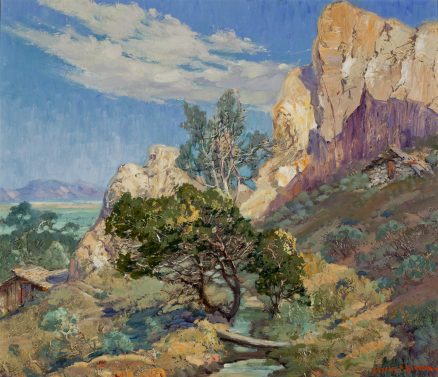- Categories
- Landscapes
- Zoom in on Artwork
- Print Page
- Email Page to Friend
Joseph Birren’s dramatic landscape painting presents the varied terrain of California in a nearly square composition marked by plunging diagonals and deep spatial recession. From the meandering stream and gnarled trees in the foreground to the distant plains and mountains, the scene is dominated by the tawny rock outcropping rising at upper right. Almost lost amidst writhing forms, strong color, and animated brushwork are two rustic mountain huts, the only signs of human presence in an otherwise wild setting. The shelter afforded these structures by the rock masses echoes the Christian theme of pure faith and surrender to divine protection expressed in the eighteenth-century English hymn “Rock of Ages,” from which the painting takes its title.
After he retired from commercial art work to paint full-time, in 1916, Birren traveled as far as Bermuda and New England in search of landscape subjects. In 1925, he visited California to paint the area around Monterey, and soon the West, particularly coastal California with its brilliant light and dramatic vistas, became his signature subject. The artist found patrons there as well. Following his solo exhibition in Los Angeles in 1925, he wrote to the Art Institute’s Charles Burkholder that half the works in the show had been purchased for local collections, including that of the Los Angeles Museum of History, Science and Art (now the Los Angeles County Museum of Art).i
A Rock of Ages vividly demonstrates Birren’s individual style of decorative impressionism. He was particularly known for his handling of trees and for his dense, richly textured paint, which, applied with a palette knife or his hand as well as brushes, added texture as an essential element in the painted representation of nature. In the late 1920s Birren named the technique “Tactilism” and himself as its “creator and chief exponent.”ii He may well have been unaware of the “Manifesto of Tactilism” proclaimed in 1921 by the Italian artist F. T. Marinetti, a leader of the avant-garde artistic movement called Futurism. For Birren’s artistically conservative admirers in the United States, his Tactilism was proof that this artist was commendably modern while avoiding the baffling eccentricities of modernism.
The painting is inscribed on the back “Rock of Ages,” while the record for its sale at auction in 1992 gives the title as A Rock of Ages, Sierra Nevada. Although the source of this subtitle is unknown, it likely describes the region depicted.
Wendy Greenhouse, PhD
Donated by M. Christine Schwartz to the Laguna Art Museum, Laguna Beach, California, in 2021
i Birren’s note to Charles Burkholder, Sept. 4, 1925, inscribed inside the cover of the brochure for Birren’s September 1925 exhibition at S. & G. Gump Company, San Francisco, in Joseph Birren pamphlet file, Ryerson and Burnham Libraries, Art Institute of Chicago.
ii Sonia Wolfson, “’Ism’ in Art Revealed by Birren at Stendahl’s,” Southwest Magazine, Sept. 1930: 21, in Joseph Birren file, Chicago Artists Archive, Chicago Public Library, Harold Washington Library Center, Fine Arts Collection.
